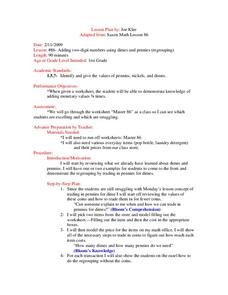Curated OER
Billions of Bubbles
Students conduct an experiment with bubbles. In this observation and comparison lesson, students read Bubbles, Bubbles, Everywhere and conduct an experiment where they test different kinds of liquids to see which is the best for a...
Curated OER
Adding Two-Digit Numbers Using Dimes and Pennies
First graders examine regrouping when adding, by using dimes and pennies to borrow. In this addition activity, 1st graders work together as a whole group, working together with the teacher.
Curated OER
Oil Spill Lesson Plans
With the recent oil spill in the Gulf of Mexico, now is a great time to educate students on issues related to oil.
Curated OER
Pronoun Agreement
A 20-item worksheet calls for learners to write the correct pronoun to replace the underlined one in each sentence. Several of the sentence topics deal with bodily functions, mildly grisly subject matter, and social norms that may be of...
Curated OER
Scientific Method, Control and Variables
Middle school scientists bathe in Bikini Bottom with SpongeBob and friends. They define steps in the scientific method. They identify independent variables, dependent variables, and the control for science experiments being carried out...
Curated OER
Oil + Water + Wildlife = A Real Mess
Students conduct an experiment. In this environmental protection lesson, students explore how oil spills affect living organisms in an ecosystem. Students work in groups to complete a lab activity and then discuss their findings.
Curated OER
Graphs
Eighth graders analyze graphs on a worksheet and in newspapers and magazines. In this graphs lesson plan, 8th graders also record their thoughts in a journal.
Curated OER
Determining The pH Of Common Substances
Students use a pH indicator to measure the pH of some fruits, common beverages, and borax. Students discover how to differentiate between an object that is an acid or a base.
Curated OER
Are Seeds in Danger?
Eighth graders discuss uses and disposal of common household chemicals. They select a household chemical to test for impact on plant germination. Students decide how they want to set up a seed germination project. They design their plan,...
Curated OER
Chemistry Scavenger Hunt
In this chemistry activity, students identify the three main phases of matter. Then they search for information about each element on a Chem Time Clock. Students use the chemical symbol to identify each element.
Curated OER
Gifts From the Sea
For this marine animal worksheet, 3rd graders study the parts of seaweed. Students label 2 seaweed diagrams and study 24 household objects, circling those that come from seaweed extracts and/or ingredients.
Curated OER
How Many Bears in the Forest?
Third graders model the tag and recapture of bears and use proportions to estimate the population of the bears in their forest. This is a statistical sampling method used by scientists and naturalists to determine population numbers.
Curated OER
You are the Microbiologist
In this lesson, students demonstrate comprehension of basic lab techniques by properly using these techniques in preparing a laboratory investigation, demonstrate synthesis of prior lab experiences by solving a new problem using those...
Curated OER
Bubbles
Students complete experiments with three different bubble solutions to determine which one creates the largest bubbles. Before conducting the experiments, they discuss the ingredients in each solution, and make predictions on which will...
Curated OER
Scientific Method
In this Scientific Method worksheet, students identify controls, variables and conclusions given experiment descriptions. Students interpret data given in charts.
















